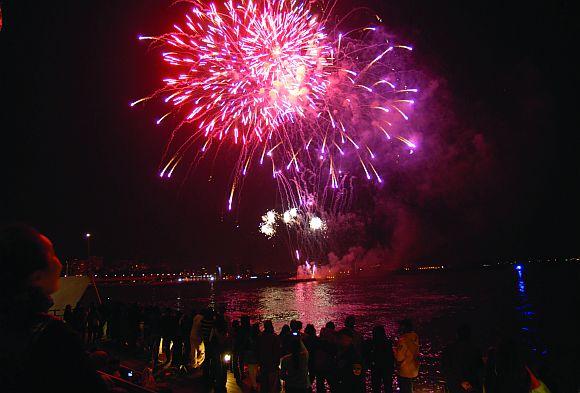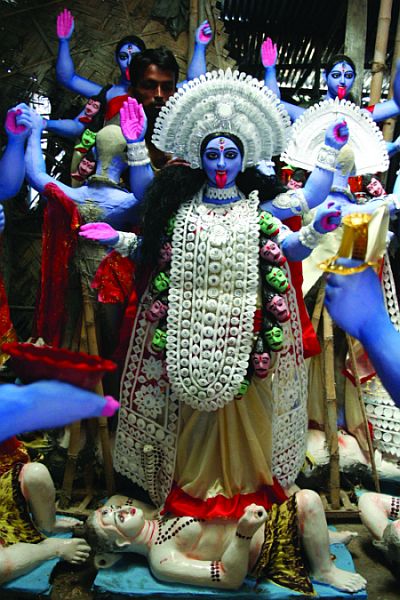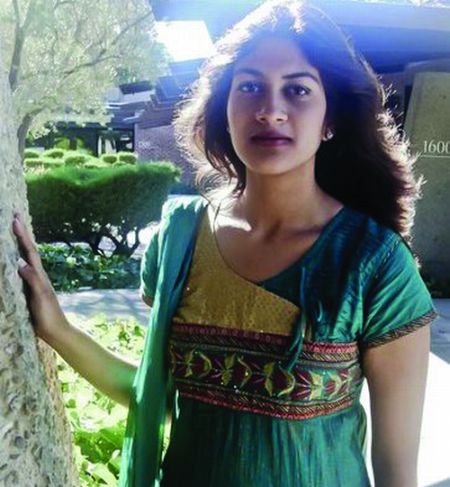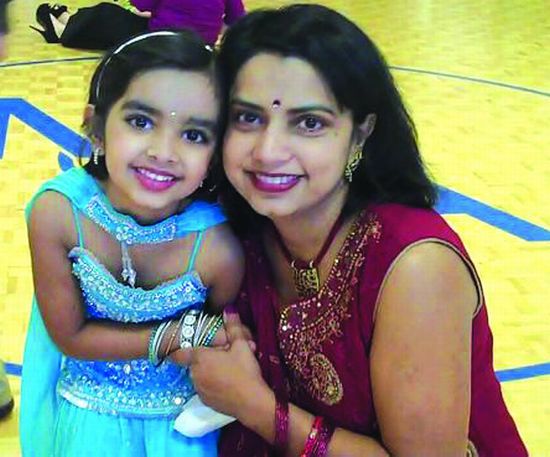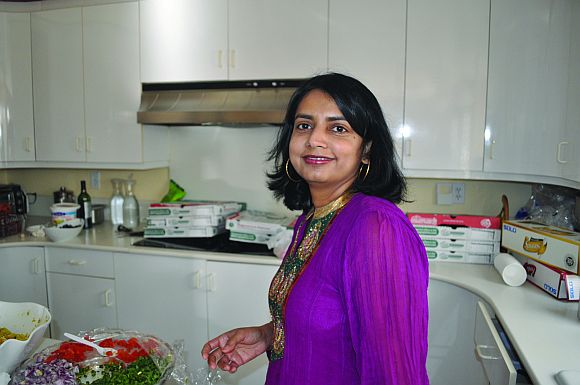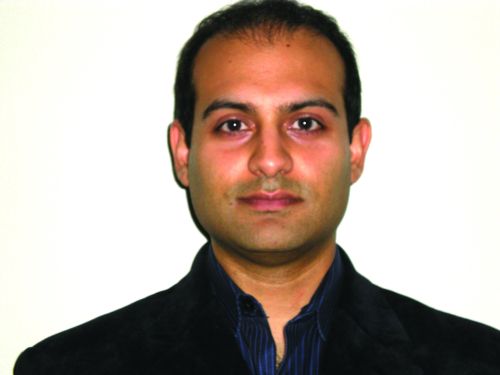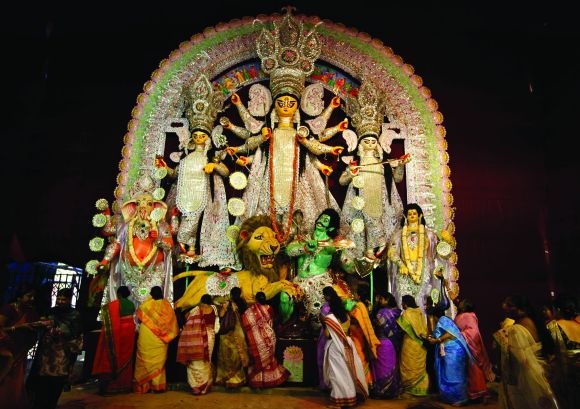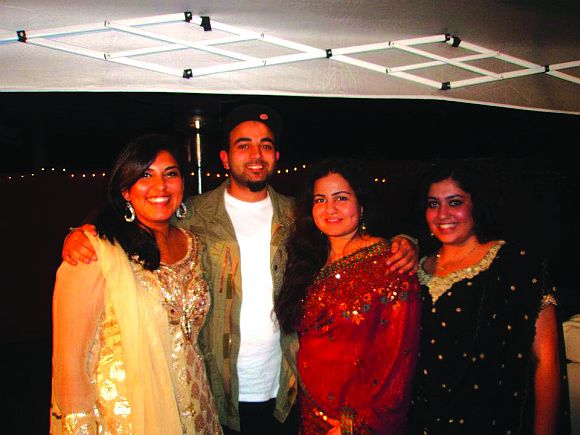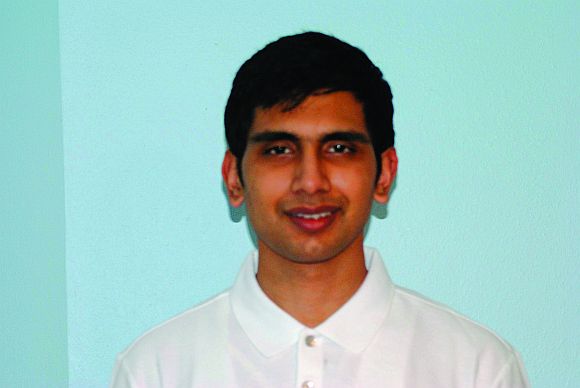 | « Back to article | Print this article |
Legacy of faith in times of Diwali
Bringing Indian festivals home for the second generation
I don't know about the origins of Durga Puja, although I know it is a celebration of Ma Durga. I know she is the main goddess for Bengalis and she destroys evil.
I remember when I was four or five there was a tradition that every year we would go to New Jersey with friends. We would spend two days there, a weekend away from New York. We stayed with family friends who would also come with us.
I remember running around with my friends. I remember the dances -- there was Kathak, Odissi and Bharata Natyam. I would be running around with my friends and my mom (an Indian-origin Bengali) would call me each time there was a dance performance.
And there was tent filled with food and a lot of mishtis (sweets). I also remember the prashad after the puja. I think we also invited some friends over for Durga Puja a few times and my mother made Payesh and Sandesh. It would be a mix of our Indian and non-Indian friends.
We continued going until the past few years. There's no one to really go with anymore. Also, I have been very busy. I do remember going to Astoria, Queens, one year and also visiting California with my mother and enjoying Durga Puja with friends there.
 |
My father is a Russian Jewish, but he isn't practicing. There is a little bit of Hanukah and we celebrate Christmas also. We do little bit of Rosh Hashanah. We did observe more of the holidays when my grandmother was alive. But Russian Jews aren't quite religious.
I will be in college next year, I am not sure if I will do anything for Durga Puja or the Jewish holidays. I will call my parents for sure. But I would do something for Holi, because it is fun and we celebrate that a lot more. I can see myself playing Holi with friends in college.
-- Aliya Tuzhilin, 17, New York City
As told to Aseem Chhabra
Click on NEXT to read further...
'It has been difficult bringing Durga Puja for Aliya'
It has been difficult bringing Durga Puja for Aliya here in New York.
It was such a big festive occasion for me in Delhi. There are very few Bengalis in New York City. And then the children are not interested in going for puja.
One of the thing is that Durga Puja is a community event and for that you have to go somewhere with friends.
Then it can be fun. But Aliya does have good memories of Durga Puja from her childhood. At least we took those trips to New Jersey.
-- Shahana Sen, Aliya's mother
Click on NEXT to go further...
'I want to keep this tradition in my life'
For me, Durga Puja was more of a social event. I do remember the prayers when you hold the flowers in your hand and pray. Every single time that happened, I really felt at peace and serene.
We would make these trips every single year when I was younger. There was always a lot of food. And I remember wearing a kurta.
Then one year, when I was 20, I was in Delhi staying with my aunt in Chittranjan Park and I attended Durga Puja celebrations there. I had never seen so many people. It was all colourful, long lines for food. We went from 5 pm to almost midnight and the event went on for a few days. And people were very friendly. I remember talking to many people.
In California, it was always smaller. We would go to Chabot College. That's where all the Bengalis from the area would gather. But last year we went to the Sunnyvale Temple for Durga Puja. It's a regular Hindu Temple.
As I grow older, I do want to keep this tradition in my life, because I do like the puja atmosphere. I really enjoy it. This is something I would like to pass on, if I have kids. There is always good food.
-- Arjun Chakravarty, 25, Sunnyvale, California
As told to Aseem Chhabra
Click on NEXT to go further...
'I use Google to learn about the rituals'
I have never been to India during these festivals, but my parents celebrate Durga Puja at home in San Diego. This is a two-day celebration (shortened significantly) and happens at a nearby school.
There are prayers, food and other cultural activities, including religious skits and songs and dances. We eat different foods for two days and are mostly non-vegetarian. Chicken and lamb masala are some of the most popular dishes.
My first Diwali celebration was at Stanford University (where she is now studying). I use Google or Youtube to learn about the rituals. I have gone on Google to learn more about the story behind Diwali, because I learned about it in a small religious group when I was around 7 and I never celebrated it in my family.
I learned about the religious-cultural significance of it in my religious community, and spending it with friends has been a great experience.
At Stanford, we have a large Diwali celebration, organised by almost all major South Asian groups on campus. It is a collaboration between undergraduate and graduate South Asian students. The undergraduate organisation also puts on a smaller scale Diwali on the day of the festival, lighting diyas (earthen lamps) around the fountain and sharing sweets among students.
At this smaller undergraduate celebration, we encourage as many people in the Stanford community to come and some of us talk about the significance of the evening and enjoy ourselves with our friends. The larger celebration has a puja beforehand followed by an Indian dinner and a garba dance.
-- Sheta Chatterjee, 20, San Diego, California
As told to Ritu Jha
Click on NEXT to go further...
'My kids actively participate in all the rituals we do'
Both Dussehra and Diwali are very important Hindu festivals. It means to me to enjoy and celebrate the festival of lights and the triumph of good over evil. We always try to have our children join the temple programmes during these festivals so that they can learn some more about our culture.
My kids are quite interested in learning about our culture and already know about these festivals and stories behind these, so it doesn't take a very long time to tell them about new festivals and occasions.
We mostly celebrate Dussehra at a temple. I go to a local temple for prayers and for Kanya Puja (where a girl child is worshipped) to a friend's place. We don't have big celebrations at home on Dussehra, but we read stories about Dussehra to our children and talk to them about Ravan Dahan.
For Diwali, the first thing we do is clean the house thoroughly. A day before Diwali we buy utensils.
On Diwali we make phone calls to friends and family to wish them. We wear new clothes, do puja in our house, decorate and put up candles around the house, and play cards. Each year we have a special Diwali party.
But the biggest part of Diwali is making special food -- which is chana daal-stuffed puris (ground lentil filled bread), a jackfruit curry and an eggplant potatoes dish. There are several types of sweets we eat, but we generally buy those. I also read Diwali stories to my kids from Amar Chitra Katha or online.
My kids actively participate in all the rituals and functions we do and thoroughly enjoy Diwali firecrackers.
Compared to India, it is not so different in terms of prayers because there are still temples and the pujas are similar. What we miss here is the festive environment that we get in India where everyone is celebrating with so much enthusiasm.
Here we do celebrate every festival and perform rituals, but we cannot replicate the festive environment that we get in India.
I grew up in a joint family where everyday feels like a festival with so many cousins to play with. Our celebrations used to be super fun in India with so many people around. Here we miss the huge family gatherings at these occasions. We, however, feel fortunate that my father-in-law stays with us so the kids get to learn and have fun with him as well on these festivals.
When I first came to the US, we went to our uncle's house and celebrated the festivals with them. They celebrated it in authentic Indian way and I got to learn a lot of things from them, which I try to follow. It was a very different experience to celebrate festivals in a quieter environment after being used to celebrating with such large number of people. It was different, but I got used to it over the years and now enjoy celebrating it the way we do now.
Click on NEXT to go further...
A festive family recipe
A festive family recipe that represents my state, Bihar is the nariyal pitha. This is my mother's recipe.
Ingredients:
Milk
Sugar
Rice flour
Grated coconut
Cardamom
Method:
Mix hot milk and sugar in rice flour to make dough.
Saute grated coconut and mix cardamom and sugar in it for the filling.
Make small circles of rice flour and put the filling in it.
Boil milk in a pan and put the rice circles in it. Once the circles are cooked, remove it in a separate bowl. Continue to put other rice circles. Once all the circles are cooked, pour the left over milk in the bowl.
You can eat it hot or cold.
-- Reena Gupta, Pleasanton, California
As told to Ritu Jha
Click on NEXT to go further...
'It is hard to convince children to observe the rituals'
I came to the US in 2002 to stay with my children. Even though we celebrate both Dussehra and Diwali, I feel a void in the celebrations as compared to the festivity in India. It is not hard to answer the hows and whys about Indian festivals to the second-generation kids, but it is hard to convince them to observe the rituals.
Career has more priority than festivals in the US, whereas in India, since these festivals are holidays, all join together in celebrations.
Like other families from south India in the US, for Dussehra we arrange clay dolls of various Hindu Gods in wooden steps and build a park and some innovative things like an airport to show our imagination and artistic flavour.
This is on display for all nine days of Dussehra. Women visit each others homes. Different dishes made out of lentils are prepared each day for offering to the God and for distribution to the visitors.
As far as cooking is concerned, there is not much difference between how we do it in India and here in the US. But when it comes to prayers, it is done elaborately on weekends and on weekdays, symbolic prayers are offered.
Diwali is celebrated in a subdued fashion here. We get up and bathe very early in the morning, wear new traditional clothes and pray to Lord Krishna who vanquished Narakasura (a demon king), as per the last wish of the vanquished the day he died, Naraka Chathurthi or Diwali, is remembered and celebrated by people by lighting lamps.
In India, the gaiety was more as the entire population irrespective of caste, creed or religion joins in the celebration and fireworks. Youngsters call on the elders and seek their blessings. Laddu, milk peda, jalebi are some of the sweets prepared on that day.
-- Krishnaswamy Narasimhan, 67, Fremont, California
As told to Ritu Jha
Click on NEXT to go further...
'I miss the fireworks during Diwali'
Our children eagerly wait for Diwali because it is like Christmas in the US. I really enjoy the festival with my children and grand children, but again there is a great difference in celebrations in India and the US.
I miss the fireworks during Diwali, since we are not allowed to burst crackers in the US.
Fifteen days before Diwali, friends and family start inviting each other for dinner parties. It is a festival of feast, so we make special food like pooris, dahi bhallas, kheer and a variety of sweets.
Navratri is more about fasting and prayers. I fast for two days either the first two days of the nine-day long period or the first and the last day. Special food for these fasts, including buckwheat flour or kuttu, is used to make chapattis.
On Ashtami (the eighth day) we perform kanchak pujan (in which the girl child is worshipped).
Dandia is popular on weekends during Navratri and we've always been participating in it.
-- Nilu Gupta, Cupertino, California
As told to Ritu Jha
Click on NEXT to go further...
'It's a time for home-cooked recipes, passed down from my grandmother'
My wife Shifali and I celebrate Diwali and Dussehra by getting together with our family, decorating our home with clay lamps and lights. We perform aarti together and my mom makes several traditional dishes and lots of mithai (traditional Indian sweets). We also go to the temple and the Diwali Mela in the Bay Area.
When I was growing up, I received money and new clothes from my parents, set off firecrackers, and hosted Diwali parties.
As a second-generation Indian, for me both festivals signify the victory of good over evil. These also provide an opportunity to be with family and friends and have fun together. And yes, it's a time for home-cooked festive recipes, which have been passed down from my grandmother to my mother and now my wife.
My mom makes halwa, aloo curry, pooris, kheer and lots of mithai. One of my mother's specialties on Diwali has always been Khoya Barfi and my wife normally makes gaajar ka halwa. Though everyone tries to cook their special recipe, much of the food we eat is similar to what my family traditionally has on these occasions in India.
My parents taught me the significance behind Hindu festivals when I was growing up, so now I have no problem understanding or enjoying them as an adult.
-- Samir Kalra, San Jose, California
As told to Ritu Jha
Click on NEXT to go further...
'We are grooming next generation Indians to appreciate their values'
My seven year old understands the religious and historic importance of these events and I am sure parents who want to keep these traditions alive, would not find it hard to instill such values in their children as well
I believe in grooming our children from a young age, I find it easier to explain to them about festivals.
I learned about celebrating Dusshera from my mother who is an organizer in a local puja committee in Kolkata. She works almost the same way that I do here, to make this event successful. My dad is an observer.
Food is an important part of the festival. We eat typical Indian-Bengali dishes like khichudi, tomato chutney, luchi, payesh, etc.
As for prayers I believe in no shortcuts. We follow the dates and time of the prayer rituals as defined in the Panjika (Bengali calendar). The material used in the ceremonies is flown in from Kolkata, since much of it is not available here. We have to make some adjustments due to legal and social restrictions, but we try to recreate the traditional experience as much as possible.
When I first came to the US in 2000, the quickest way to get assimilated in the local Indian community was through participation in Dussehra, Durga Puja and Diwali programmes.
For a part of our stay initially, we would check out the local festivals and go there as visitors. These events, for us, were a way to network, meet new friends and reminisce about old times in India.
In the initial days that I spent in New York, New Jersey and Maryland -- where these festivals were weekend fare -- community food, Bollywood or Tollywood dominated the stage. Those few hours vaguely reminded one of their background and culture, customised as they were for the US lifestyle.
Then we started our own puja in Pashchimi, an organisation that celebrates Durga Puja in the Bay Area. Dissatisfied with the way Indian tradition was represented, we decided to make it as authentic as possible. We changed from receivers of a diluted from of cultural perception to a more holistic and representative form of tradition and values.
We now spend a better part of the year planning, and executing the event. We are grooming the next generation Indians to appreciate their values, background and tradition, thereby making them world citizens and creating a confluence of multiple races and cultures to make America richer.
-- Bibek Das, Pleasanton, California
As told to Ritu Jha
Click on NEXT to go further...
'Not many think about the history and stories behind these festivals'
I came to the San Francisco Bay Area when I was 12. I have fond memories of Dussehra and Diwali festivals in India. It meant decorating the house with diyas, wearing pretty new clothes and playing cards.
Here in the US too we try to recreate the same atmosphere. While my generation isn't too keen on playing cards on Diwali, our parents and their friends still get together for a night of cards.
Navratari has its special charm, with Dandia events, including dance, music, food, and shopping.
Our celebrations are quieter here in the US, but the joy and fun behind these festivals is the same when you go to any Indian household. Even the most mundane ritual was taught to me from early childhood, but for those living alone or away from home, Google and Youtube provide the background needed to make these rituals feel real.
Festival rituals are not difficult to understand and can be performed easily. Most of us forget what the festival is really about. Not many of my generation, really stop to think about the history and stories behind these festivals.
-- Taruna Chhabra, San Francisco, California
As told to Ritu Jha
Click on NEXT to go further...
'As a child growing up in America, my parents taught me about our culture'
As a child growing up in America, my parents taught me about our culture and I was drawn to it. I was not particularly religious growing up, but I did do puja and visit the temple with my family.
Durga Puja holds special significance for our family as we are Bengalis, and we celebrate by going to the temple during the puja.
The celebration there is nice, but it is not done as per Hindu Dharma. We do puja at home for some festivals like lakshmi puja, but generally we go to the temple as a family.
As I grew up, I began to wonder why the various rituals were done as they were... and slowly, I began to lose faith and interest in our culture.
Things continued like this for some years, but the dormant curiosity about dharma never left me. I would read books about saints like Ramakrishna Paramahansa and feel that what they said made a lot of sense, but I also felt that I would never be able to tread the path to God as they did.
Due to certain circumstances, I was able to start spiritual practice with a non-profit organisation (in Goa) 2 years ago, and this time I stayed consistent.
After coming back to America, I have a different view of celebrations held at the temples here. They are beautiful no doubt, but the connection to God, that deep spiritual significance that is the key to Hindu dharma is somehow lost...
The focus is more on the social event instead of the divine. Malpractices like denigration of deities by printing their images on shirts, etc and incorrect methods of worship like using candles instead of a ghee lamp are common.
Personally, I am amazed that Hindus are okay with this. We deserve better.
-- Auritro Mallick, 25, Houston, Texas
As told to George Joseph
Click on NEXT to go further...
Top PHOTO features of the week
Click on MORE to see another set of PHOTO features...
